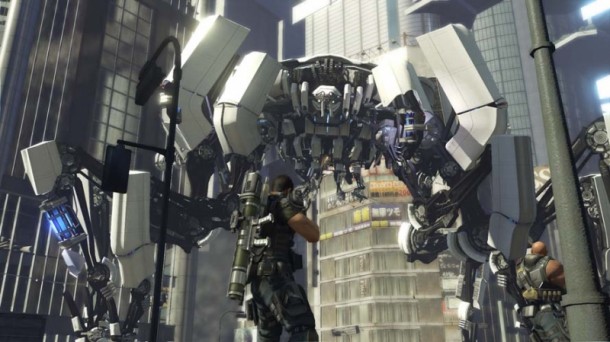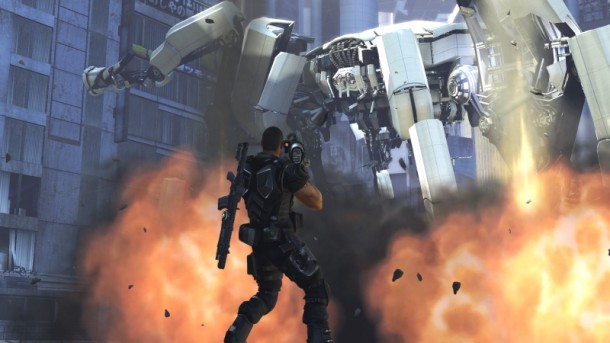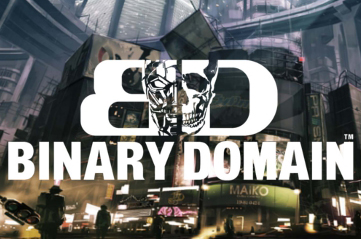Here is yet another attempt by an Eastern company to make a Western-style third-person shooter. More often than not, you end up with a game like Dirge of Cerberus or Quantum Theory. It’s not often that the end result turn out to be a great game that should be played by many.
In steps Binary Domain. Binary Domain doesn’t bring anything new to the table.. In fact, at its most basic, it is a standard third-person shooter. However, the progression elements pulled in from an a RPG make the combat much more satisfying. Dan “The Survivor” Marshall is an assault rifle specialist. He carries around his trusty weapon as if it is his best friend. Unlike other games where characters are attached to certain weapons, it actually means something here.
This is seen when in the many areas you visit in Tokyo, you will come across vending machines that will dispense many items. Instead of finding instant noodles, vegetables, or eggs, you find more helpful items such as weapon upgrades, ammo, and health packs. Much like BioShock, these stations are used to bolster your weapon’s power and accuracy, amongst other things. Each of Dan Marshall’s companions each has a weapon that can be upgraded when they are in your party.

Your space-buck currency is earned in the most convenient of ways: Destroying effing robots. Enemy robots that you are facing are all plated with alloys and such that you must shoot off in order to put an end to each robot. Shooting off legs will force the enemy to crawl at you, while removing the heads will cause them to start going berserk and shooting other robots. The way the enemies shed bits of their bodies while being shot gives you a very tactile feel and feedback that is uncommon in third-person shooters.
Each type of robot that you face has a distinct look. The entirety of the art direction looks like an amalgamation of the 2010 game, Vanquish, and the 2004 film, I, Robot. The stunning cityscapes of the year 2080 Tokyo is simply fantastic. From a moment of downtime at an urban outdoor coffee shop, to fighting through slums, you are treated with a unique visual style that I haven’t seen in any other videogame.
With all of that said, there are a few components that while minor by themselves, combined to be a thorn in my side. At any moment in Binary Domain, you will be seen bumbling around with several cohorts. In total, you will have the choice (at certain points) of who you want in your party. I chose two other fellas by the names of Charlie, and “Big Bo.” Their intros in the story were powerful, so I wanted them by my side. Faithful and strong companions they were, too. Whenever I came across one of the gun-upgrading vending machines, I spent some robot-killin’ bucks on them.

Everything seemed to be going great with Charlie and “Big Bo.” But then, they started repeating the same phrases. Each character has about five or six catch phrases that they felt was necessary to say every minute or two. It got aggravating. So what could I do? Switch characters so as to hear new sayings? Well, I felt I couldn’t do that as I had spent significant money on upgrading those characters’ weapons. So I lived with it. Eventually new characters are forced into your party anyway, so the decision was taken out of my hands. While it gave me the new characters that I desired, any pretense of choice that the game was offering disappeared at the snap of a finger.
With each character in my party, I had equal gripes: They could get lost trying to find their way to either end zone from the 50 yard line. What I mean to say is the AI pathing was flat out atrocious. I didn’t notice until I reached a point where I was having to navigate through tight corridors at a decent rate of speed. Every 30 seconds or so, I had to circle back to my companions and issue the command “Regroup” or I would find them running into a wall somewhere.
Beyond that, Binary Domain fancies itself a tactical game. Using your headset you can bark some 50-odd words and sayings at your comrades. When in combat you can give orders for your allies to cover you, or to take point and charge down the enemy. It works rather well most of the time, as long as you follow general voice command usage (speak slowly and enunciate). In other instances characters ask Dan Marshall questions, and you are tasked with responding. However, most of the time the things you can say aren’t what you actually want to say. As with the pretense of choice, the pretense of needing a headset was thrown out when I discovered I could quickly issue commands with my controller. While using voice commands was interesting, it ultimately didn’t work well enough to make me want to use it.

That problem is small, though, as those instances aren’t really make or break. They are more of a little aside in the overall story which I found to be quite unique. Even though the influences are worn proudly on the chest of Binary Domain, the last three hours of gameplay featured about 37 different twists that I didn’t expect. In an anime fashion, they were all fitting and actually made sense. I was expecting to tune out the story after a few minutes, but I was surprised to find myself enraptured until the very end.
Between the well-crafted narrative, the fun combat, and the simple yet addictive upgrade mechanics, you are in for a treat if you grab yourself a copy of Binary Domain. Now, I know the title is generic as all hell, but I assure you, this game is one well worth playing.
This review is based on a retail copy provided by Sega for the Xbox 360.
Binary Domain is available now for Xbox 360 and Playstation 3.


No Comments